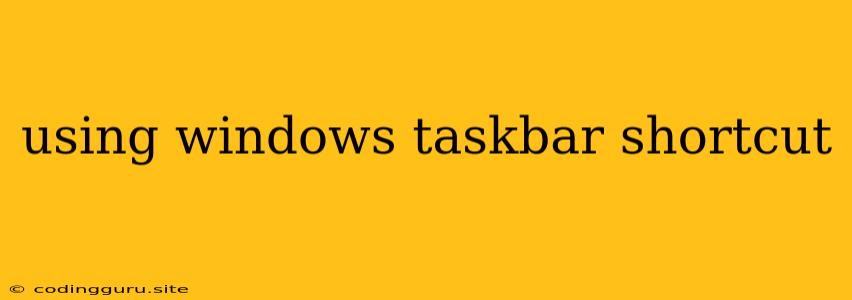Harnessing the Power of Windows Taskbar Shortcuts
The Windows taskbar is more than just a simple bar at the bottom of your screen. It's a powerful tool that can significantly boost your productivity. One of its key features is the ability to create shortcuts that launch your favorite apps and files with a single click.
Why Use Taskbar Shortcuts?
- Speed and Efficiency: Forget the hassle of digging through your Start menu or file explorer. Taskbar shortcuts give you instant access to frequently used apps and documents, saving you valuable time.
- Organization: Keep your most important tools readily available and easily accessible. This keeps your workflow streamlined and prevents you from getting bogged down in searching for specific items.
- Customization: You have complete control over what shortcuts appear on your taskbar, tailoring it to suit your individual needs and preferences.
How to Create Taskbar Shortcuts
Creating taskbar shortcuts is incredibly simple. Here's a step-by-step guide:
- Locate your desired app or file: This could be an application, a document, a folder, or even a website.
- Right-click on the item and select "Pin to taskbar."
Additional Tips for Taskbar Shortcuts:
- Pin Folders: You can pin entire folders to the taskbar to access their contents easily. Simply navigate to the folder in File Explorer, right-click, and choose "Pin to taskbar."
- Pin Websites: You can also pin your favorite websites to the taskbar. Open the website in your browser, right-click on the tab, and select "Pin to taskbar."
- Customize the Shortcut: You can adjust the appearance of your taskbar shortcut by right-clicking on it and selecting "Properties." Here, you can change the shortcut icon or adjust the target path.
- Rearrange Shortcuts: To reposition your taskbar shortcuts, simply click and drag them to your preferred location.
- Remove Shortcuts: If you no longer need a shortcut, simply right-click on it and select "Unpin from taskbar."
Going Beyond the Basics: Advanced Taskbar Shortcuts
For power users, the Windows taskbar offers even more advanced customization options. Here are some examples:
- Jump Lists: Right-clicking on a taskbar shortcut reveals a "Jump List," which shows recent files or actions associated with that program.
- Taskbar Groups: You can group related taskbar shortcuts together by dragging and dropping them onto each other.
- Taskbar Previews: Hovering over a taskbar shortcut displays a thumbnail preview of the app's window.
Benefits of Using Taskbar Shortcuts:
- Increased Productivity: Quickly access your most used tools, reducing time spent searching for files or applications.
- Improved Workflow: A well-organized taskbar keeps you focused and efficient, minimizing distractions.
- Personalized Workspace: Customize your taskbar to perfectly suit your individual needs and preferences.
- Enhanced User Experience: Enjoy a streamlined and efficient interaction with your computer.
Conclusion
The Windows taskbar is a powerful tool for organization and efficiency. By mastering the art of using taskbar shortcuts, you can unlock a whole new level of productivity and enhance your overall user experience. Embrace the power of shortcuts and streamline your digital workflow today!
